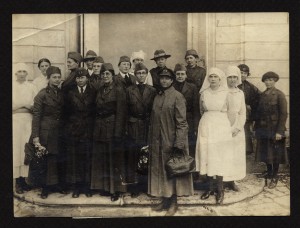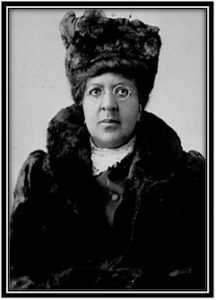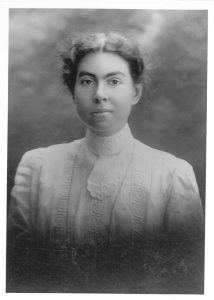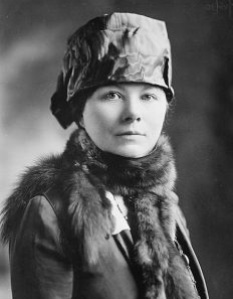This Veterans Day, We Celebrate a Long Tradition of Women in Service

Members of American Women's Hospitals (AWH) leaving for Europe.
November 11, 2018
I was at the Philadelphia airport just a few days ago getting ready to board a plane to head to a conference. After more than 23 years of traveling, I rarely pay attention to the boarding announcements anymore, but I knew that my "zone" would be called right after families and active duty military, so I began gathering my things as the gate agent invited members of the armed forces to board and looked up to see a young woman in uniform disappear into the jet bridge. I can't explain why, but I was filled with a sense of awe and gratitude. And then it hit me, Veterans Day is only a few days away and this year marks the centennial of the signing of the Armistice between the Allies and Germany. It was at the 11th hour on the 11th of November 1918 that the ceasefire would go into effect and end World War I. I couldn't help but wonder who were the women that played such a pivotal role in changing our US Armed Forces.
As soon as I returned to Philadelphia, I reached out to the College of Medicine's Legacy Center, a repository for the records and heritage of Drexel University College of Medicine and its predecessor institutions, including Woman's Medical College of Pennsylvania (W/MCP) and Hahnemann University. Given our rich history in educating women physicians, I was certain they'd have a lot of stories to share about the role of women doctors in the US military.
As I suspected, they were more than happy to help and did indeed have a lot of information regarding women physicians but made it clear that their role in WWI was complicated. I had a lot of material to dive into, so I decided to get started. I couldn't wait to discover their contributions to our military on the front lines as women physicians!

Dr. Harriett Allyne Rice
I began by checking out an exhibit by the American Medical Women's Association (AMWA) titled "American Women Physicians in World War I." The opening paragraph began to give me some insight into the complexity of the history of women physicians and World War I." Despite women physicians' strong willingness and desire to help during the war, they were denied the chance. As soon as the US joined the war in 1917, the Army Surgeon General sent out a call asking for all physicians to register to serve on the Medical Corps, and many of our doctors responded to the call. Unfortunately, all applications from women physicians were rejected. Not easily defeated, they appealed the decision and presented evidence of their ability to serve just like their male counterparts. At that time, women represented only 6% of US doctors but they were 30% more willing than their male counterparts to answer the call. And answer the call they did, despite the government's decision to deny their appeal to grant them entry into the Medical Reserve Corps.
View Video: At Home and Over There: American Women Physicians in World War I
Many served as volunteer doctors and cared for women and children in war-torn countries. Others went as contract doctors for the US military, forgoing the ability to receive equal pay, military commissions and benefits. Their desire to serve outweighed their immediate need of a military commission. Fifty-five women "contract surgeons" were accepted and eleven of those served abroad. Those eleven were trained as anesthetists, so that it was clear that their role would not be as surgeons.

Dr. Alice Weld Tallent
Still others went abroad to serve the French Army, where they were welcomed and even received accolades, awards and medals. Dr. Harriett Allyne Rice, a 49 year-old African-American physician, answered the call and was awarded the Bronze Medal – an honor that she would not receive from her own country's army.
Dr. Alice Weld Tallent first served with a unit from Smith College (her alma mater) and then with the Committee for Devastated France. Toward the end of the war she served with the French Army, where she was awarded the rank of Lieutenant. This paints a picture of how women doctors were able to get involved. Countless others volunteered to lead and serve organizations such as the American Red Cross and the American Women's Hospitals.
The largest medical women's association was the American Women's National Association (later known as the American Medical Women's Association or AMWA). It was founded in 1915 and, almost immediately, the organization focused on war efforts and created the American Women's Hospitals (AWH). They opened their first hospital in France in 1918 and registered more than 1,000 women physicians in their first year. One of their members was Dr. Esther Pohl Lovejoy, who, in my opinion, described the journey of women physicians in WWI the best. She wrote, "The men of the medical profession were called to the colors and the nation stood ready... the women of the medical profession were not called to the colors but they decided to go anyway!"

Dr. Esther Pohl Lovejoy
It was clear that called or not, welcomed or not, our women physicians were going to stand up, show up and serve their country in the ways they knew how in order to help those in need. There is no doubt that their contributions during and after the war paved the way for women today, in the profession and in the military. In 1943, during World War II, women physicians were finally able to join the Medical Reserve Corps as commissioned officers and doctors. Margaret Craighill, then Dean of the Woman's Medical College of Pennsylvania, left her post and became the first woman medical officer in the Corps.
As we celebrate the 100-year anniversary of Armistice Day, now known as Veterans Day, let's remember to thank those who serve and have served our country, but let's also take the time to remember those who came before us and fought a different kind of war on a different kind of battlefield. We have a long way yet to go, but let us take the time to celebrate how far we have come.
Happy Veterans Day. Thank you for your sacrifice!
Issa DiSciullo, MS
Director of Diversity, Equity & Inclusion
Photos courtesy of The Legacy Center, Drexel University College of Medicine.
Back to Top